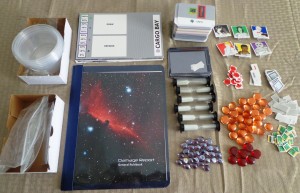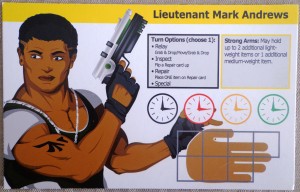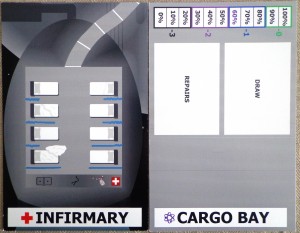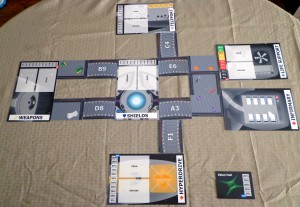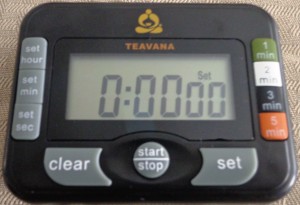I recently had the pleasure of reviewing FTL, a video game that tasks the player with managing a ship and its crew as you guide it from sector to sector. You’ll be fighting off attacks, repairing battle damage, the works. Imagine my surprise when I found a board game that does something very similar. To top it off, it does something uniquely special that turned out to be a breath of fresh air when compared to the other board games in my collection.
Damage Report is a real-time cooperative game that tasks players with surviving various situations as they arise. The game sports scenarios that players will be trying to defeat…mainly by working both as individuals and as a team. Before I begin taking a deeper look at the game, I’d like to thank Wombat Sanders and Eric Salyers for sending me a prototype copy. It should be noted that because this is a prototype copy, the rules, gameplay mechanics, and components that I mention are subject to change.
Gameplay
First, let’s talk about how the game plays. Each player will choose a character that can perform special abilities. Rather than taking turns one at a time, players will be given sand timers that equate to fifteen seconds of time when exhausted. Players will be performing actions every fifteen, thirty, forty-five, or sixty seconds, depending on the character involved and the condition of the ship’s systems. While waiting for their turn, players will be busy planning their next move but will also be trying to communicate to others on what they might need or where they plan to go. Actions can include hauling supplies around the ship (relaying), drawing a card from a particular module deck to see what is needed to fix a damaged system (inspecting), placing items onto repair cards to assist in fixing damaged systems (repairing), and other special actions that might be available as indicated by the scenario rules, modules, and character abilities.
The ship itself is made up of modules, both large and small, that will assist players in accomplishing their objective while at the same time, threaten to spell their doom. The larger modules house systems like shields, weapons, hyperdrive, and so on. Connecting those larger modules together are smaller modules, which are made up of corridors and various supply “closets”. Each module will be instrumental in helping the players complete their objectives while they try to prevent the ship from falling apart. Some of the larger modules have a tracker that will let players know at what percent that system is functioning…letting them get too low could be disastrous for everyone involved! Take the shields for example…if they drop to zero percent and an attack card is drawn, the ship suffers hull damage, which is obviously a bad thing. On the other hand, keeping it online and functioning fully will reduce the amount of damage you take when that next attack card is drawn. Having low life support will increase the amount of time players need to wait in between turns (in most cases), just to name another example.
Next, let’s talk about scenarios. There are two listed in the prototype rulebook that I received…one that requires players to stave off an enemy ship (Save the Meteora) and one that puts players into the middle of an asteroid belt (Save the Nebula). Each scenario shows a picture of how the ship’s modules should be set up and it should be noted that not all modules will be used in every scenario. For example, the former scenario has a weapons module whereas the latter scenario has a hanger deck and cargo bay module. Each scenario will have a list of victory conditions and loss conditions, along with a possible set of special rules that players will need to consider as they play the game.
Finally, I’d like to touch on the real-time mechanic. As I mentioned above, players will be given a sand timer in order to let them know when they can take their next turn. While that is going on, a separate digital “attack” timer (so it was in my prototype copy) will be counting down. Once it goes off, an attack card is drawn, which indicates how the ship is to take damage. Depending on the status of the shields and the ship itself, hull damage can occur, systems can be damaged, and corridor breaches can injure the crew. The severity of this damage is based on the shield strength of the ship…the stronger the shields are, the better. The last attack card in the deck is seeded with the “Game Over” card…players have until this occurs (unless a loss condition occurs sooner) to complete one of their objectives.
The Review
I have to say, I was blown away by the real-time mechanics. It’s not something I see often and I don’t believe I own a board game that operates in real-time (sadly, I lost “The Omega Virus” during the backlash of Hurricane Ivan). Play is fast and furious…often chaotic. New players may often be at a loss on what to do and where to go and the ticking timer doesn’t help matters. It may take a few games for new players to get used to the mechanics, though even when they do, the adrenaline will be pumping and arms / hands will be flying every which way to complete their turn. I’m sure it’s not “by-the-book”, but for our first few games, I increased the time limit on the attack timer so that attacks would occur at greater intervals. It gave me time to help coach the kids while getting them used to how the game functioned. As we get better at the game, we can decrease the timer and possibly follow some of the rule variants that offer greater challenges to players who dare to try them.
For as crazy as gameplay can get, it turns out to be an excellent team-building exercise. For the majority of the first game, we were so focused on our own characters that we didn’t have time to worry about anyone else. On occasion, I’d let Vinnie (11) and Anthony (16) know what my plans were, but I could tell that they were busy learning the game itself while trying to formulate strategies. As I get better at the game, I might (and I stress might) be able to take a leadership role and help guide them…though if your life support is fully functioning, fifteen seconds may not be a lot of time to make executive decisions for the group. Thus, players will be relying on each other and trusting each other to do their jobs. By the same token, they will need to find a way to communicate amidst the chaos so that they can keep each other in the loop. I found it to be a very interesting and enlightening experience as I was torn between doing my own thing and making sure the rest of the team were staying on task with what they were doing.
Overall, I enjoyed the game as did the kids. It’s a very social experience, one that not only calls for quick thinking but requires everyone to communicate effectively. If you enjoy cooperative games like Pandemic and would like to try something fast-paced, then Damage Report is the way to go.
If the above sounds like something that would interest you, there’s still about two weeks left to support it on Kickstarter (as of 9/21/12). It should be noted that Damage Report has already more than tripled its funding goal. You can check out the Damage Report Kickstarter page here:
You can also learn more about the game on the Break From Reality Games website and BoardGameGeek, located here:

